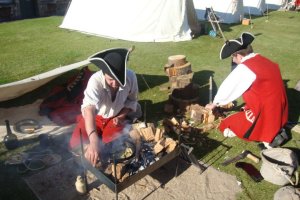Having looked at what a mess was last week, this week we will look at what exactly soldiers were eating, how they cooked it and how they ate it.
The basic ration in the British Army at the time of the Seven Years War was one pound of beef and one pound of bread per day. If beef or bread were unavailable they would be repalced with salt pork and hardtack. Interestingly enough these rations were similar to those issued to Cromwell’s army at the Siege of Drogheda, each recieving bread, beef and pease. Other foods stuffs were issued when available and as we have seen soldiers were expected to suplement these rations with produce bought by the mess.

"A soldier pot always boils with a fury" soldier preparing a meal with new recruits in Yorkshire, 1760.
It stands the reason that solders bought whatever was seasonally and cheaply available at local markets or from sutlers attached to the various regiments. For example our much quoted soldier of the 68th prepared a broth of “which was a shoulder of mutton the vegetables were some long coleworts” (unknown:11).
Having gathered his provisions a soldier would then go about cooking them as best he could. Each regiment would construct kitchen, these would be 4 to 5 foot circles of earthern in construction with fire places dug into the side. Each company would have a kitchen and each mess would require it’s cooking place (Bland:245).
Each mess was issued a tin kettle in which to prepare their rations and the mess would select it’s cook from within it’s ranks. The method of cooking invariably was to create a broth or stew, Robert Jackson wrote “that the soldiers pot always boils with fury” in 1804 when describing the method of cooking employed by most soldiers (234). Again a soldiers journal paints a vivid picture of this in 1758.
“Now I began to commence to cook; in the first place I lighted my fire, then filled my kettle with water, put in my meat, which was a shoulder of mutton the vegetables were some long coleworts and I had instruction to make a broth. But I managed indifferently it was the first attempt I had made in the art of cookery (unknown:10-11).”
Having prepared this broth to the best of his abilities, Jonas, as he was known to his comrade is ordered to bring the stew to his mess mates. His recounts how the meal is divided between the mess, “after the meat was divided and called, every one took up his lot, and proceeded to eat the broth in the best manner we could, with our canteen top as spoons” (unknown:12).





